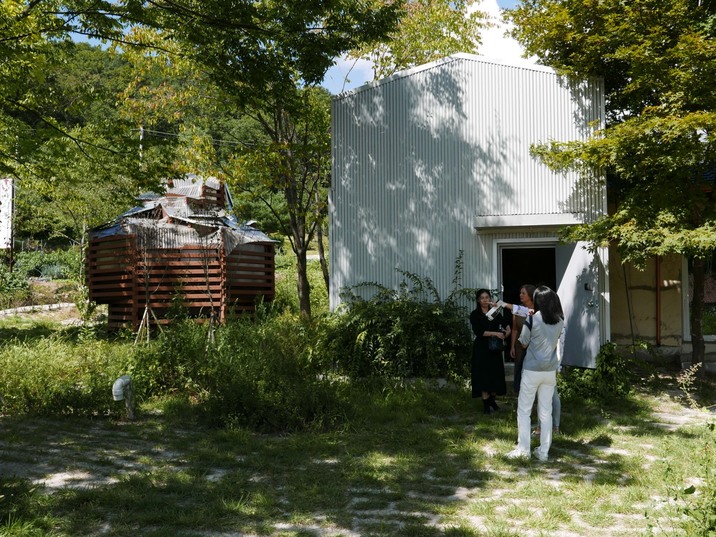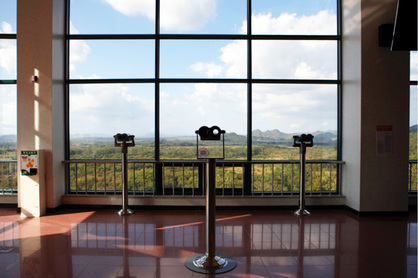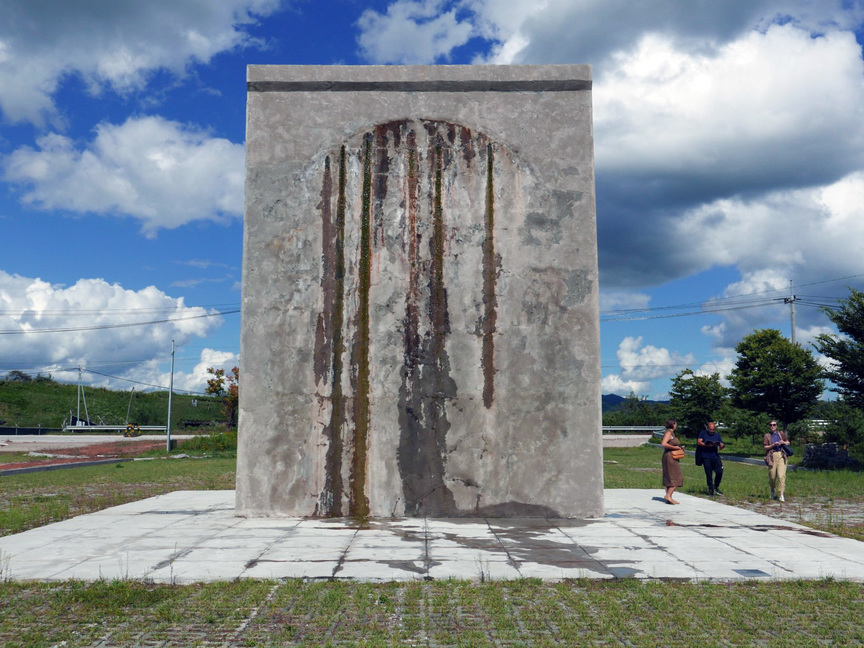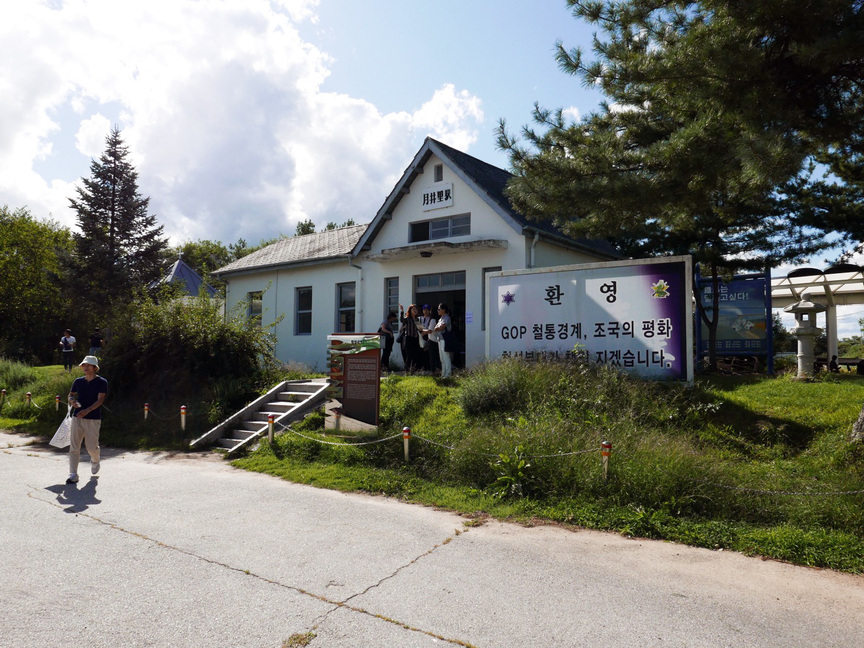
R
E
V N
E
X
T
From the monorail going up to the Cheorwon Peace Observatory, a South Korean reservoir is visible in front of the DMZ with the mountains of North Korea in the distance. All photos by HG Masters for ArtAsiaPacific, unless otherwise stated.
The demilitarized zone between South and North Korea was an eerily quiet place in September 2018. It was almost anti-climatic to see, considering its renown as one of the most contested areas of the world. But it has been a historic year on the Korean peninsula, with leaders of both sides visiting each other (and flashing K-Pop finger hearts by Heaven Lake), as they conduct talks that might finally end the Korean War (1950–53) that was halted in a United Nations-brokered armistice near the 38th parallel 65 years ago.
Since 2012, Samuso: Space for Contemporary Art has produced the Real DMZ Project, inviting artists to conduct research and create projects about this volatile area. (Strictly speaking, the DMZ itself is off limits. The Civilian Control Zone is, despite its name, the area south of the DMZ that is occupied by the military and is where the projects are located.) As a forbidden zone, the DMZ and North Korea beyond it hold the magnetic appeal of the unknown, or the unknowable, but the Real DMZ Project is also about South Korean society itself. As artistic director Sunjung Kim explains in her introductory text to this year’s edition: “The pain, loss and other traumas caused by the war and division have become internalized as part of our society and individual lives [. . .] Constantly reminded of the tragic war, military confrontation and ideological conflict by propaganda campaigns, we in South Korea have tried to forget rather than remember about the North. Like a specter, North Korea is invisibly haunting us in our daily lives and culture.”
To tour the Real DMZ Project 2018, guests boarded two buses outside the Artsonje Center in Seoul. After a two-and-a-half hour ride north toward Cheorwon, we arrived in the tiny hamlet of Yangji-ri, which was built as a showcase village by the South Korean government in the 1970s and is now home to a dwindling population of senior citizens. There is a bird rescue shelter, and in the autumn, bird-watchers come to the village to see the migrating cranes. It is also home to several artists’ projects and the Real DMZ residency space, which has a small studio and basic living areas. In an emergency shelter in the village, Florian Hecker presented a sound work, Reformulation (2014), comprising three suspended speakers emitting piercing sounds that create a sense of tension and the kind of panic one would imagine feeling if indeed conflict broke out. The Real DMZ Project has acquired a dilapidated rice mill, which will be the site of Tobias Rehberger’s long-term project The Duplex House (2018), a home for two families—one from North Korea and the other from South Korea—after re-unification, with a shared entrance room, separate living areas, and two separate kitchens occupying the same space on the top floor. Adrián Villar Rojas has been engaged in a “never-ending” project in the village since 2014, which now spans two films (the latest of which was shown in the concurrent Gwangju Biennale 2018). The Real DMZ project acquired the home of Mr. Hwang when its elderly resident moved to the city, and Villar Rojas has largely preserved its interiors and some of Mr. Hwang’s clothing, except for slight alterations, using the textures of the wallpaper and remaining objects as a kind of three-dimensional collage inside the space.
From there, we went to the hilltop Cheorwon Peace Observatory, where you can see into the DMZ, including the propaganda village Kijong-dong, located in the North Korean half of the area. Sitting in an auditorium, we were subjected to a welcome video that sounded like it had been made by the United States military to terrify visitors. In that same space was Tomás Saraceno’s 360-degree rotating binoculars DOF (Degrees of Freedom) (2014), which look similar to the other optical devices in the space, except this pair can swivel in all directions—including at the sky and even at the inside of the room—instead of being fixed toward the DMZ, defying the “perceptive obsession” of the Observatory to gaze at the North. The soldiers repeatedly reminded us that taking pictures of the DMZ and North Korea is illegal but many people did it anyway.
Next on the itinerary was the massive Peace and Culture Plaza in Cheorwon, a white elephant of a project that is overgrowing with weeds. There, Gimhongsok’s concrete sculpture, The Wall (2018), appears to weep, with water from a nearby stream leaking down its over-four-meter tall facade. It is a simple concept but deeply affective. Nearby, Yeesookyung’s sculpture You Were There (2017) features three cairns made with rocks from the northern and southern borders of Korea (Cheorwon, Haenam and Jeju Island), covered in 24-carat gold leaf, which is meant to evoke a process of transformation or enlightenment. Also using boulders was Michael Joo’s Absentialis (2018), a “collection and displacement” of seven volcanic boulders surrounding a cast cement sculpture made from digitally scanned fragments of rocks from the Hantan River, collected by local kids. The components were scattered on the Plaza and connected by painted lines, recalling the children’s game of Ttang-tta-meok-gi. A second, related part of the project was shown at Artsonje, where Joo screened a video about the river and the stones used in his sculpture, and also showed the molds used to make the three-dimensional sculpture.
A short walk from there, very close to the DMZ itself, was Woljeong-ri Station, which used to be an important point along the railway to the North. Now, an abandoned train lies in its yard. Inside the abandoned station, Yong Soon Min showed two videos, On the Road: Northern Exposure and Bangabsubnida: Rainy Day Women, both recorded on Min’s trip to North Korea in 1998. Slogans related to North Korea were carved into benches: “Northern Men, Southern Women.” On the walls, she showed fans made of two postcards, from North Korea and the Panmunjom Joint Security Area of the DMZ, respectively, that had been spliced together.
Our final stop was to Byron Kim’s Sky Blue Flag (2018), located near Soi Mountain, just outside the Civilian Control Zone. On the clear September afternoon of my visit, Kim’s patchwork painting—made from indigo color produced from jjok seedlings planted in Yangji-ri village—instead of marking ground or asserting control, nearly disappeared into the sky. As the figure-ground relationship between object and environment collapsed, the work read like a gesture of peace and reconciliation. We all live under the same sky, even though national borders circumscribe our movements and define our perspectives. Kim’s was a hopeful, even romantic gesture—much like the Real DMZ Project itself—that suggests there are different times to come.

















